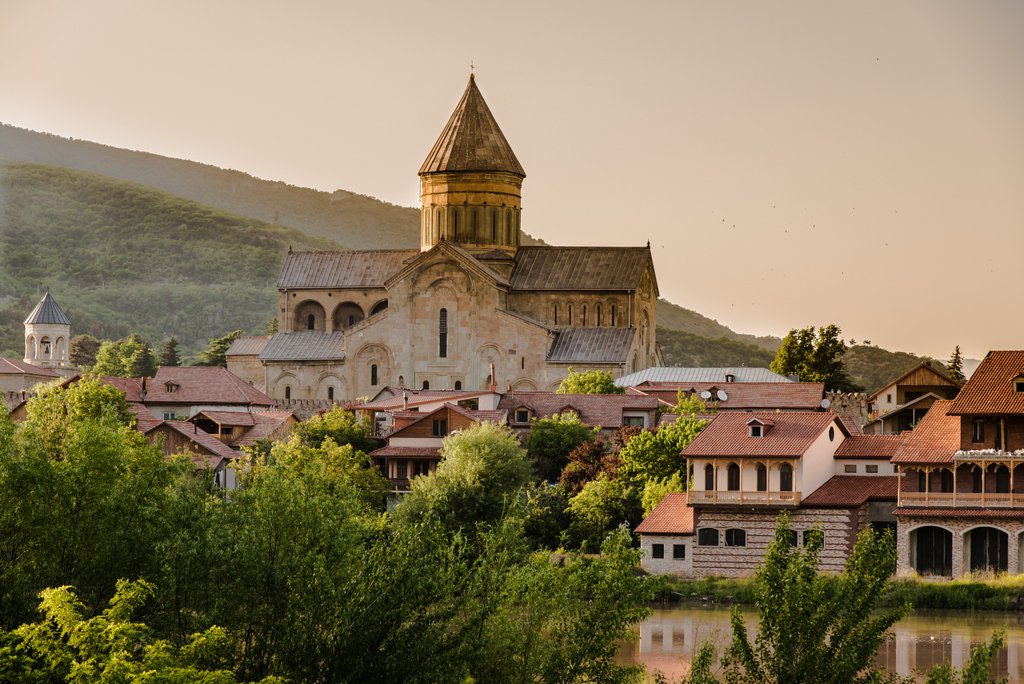It was the Ukraine where Parajanov created the film that brought him the world fame - his Ukranian masterpice Shadows of Forgotten Ancestors (1964). The succes and the importance of Sergei Parajanov's revolutionary film was compared to Sergei Einsentein's 1925 classic Battleship Potemkin . Parajanov shot the film in the Hustul (Gustul) dialect of the Ukranian language (Tini Zabutikh Predkiv) and won countless awards, including the Grand Prix of the Mar Del Plata Film Festival,Rome Film Festival and the British Academy Award, all in 1965. Shadows of Forgotten Ancestors (the most important Ukrainian film since the silent movies of Dovzhenko) was full of religious and folkloric themes and didn't conform to the dominant "social realism" of the Soviet cinema. Sergei Parajanov was blacklisted and his next film the Kiev Frescoes was stopped and banned in 1965.
In 1966 Parajanov arrived in Armenia and in 1967 completed the ..ary Hakop Hovatanian (1967). That same year he met Mikhail Vartanov who began the shooting of the The Color of Armenian Land (1968) on the set of Sergei Parajanov's absolute masterpiece, the jewel of Armenian and world cinema, the magnificent Sayat Nova . Due to the film's non-conformity to the Soviet ideology, Parajanov was forced to change and rename it into the Color of Pomegranates and then ,in 1969, Soviet director Sergei Yutkevich re-edited and made the censored Russian language version of the film (Tsvet Granata) - regardless it was banned and shelved for a very long time. Sergei Parajanov's screenplays of Intermezzo, Ara the Beautiful, Demon and the Miracle of Odense, which was co-written by Viktor Shklovsky, were rejected. On the 17th of December 1973, Sergei Parajanov was arrested in Kiev and in 1974 was senteced to 5 years in the Ukranian Prison .. Parajanov continued to creat his art even there and it helped him survive. He made madly fascinating collages, drawings and wrote shocking and unbelievable letters full of wisdom.
The world's prominent artists, filmmakers and activists campaigned for his release from camps. French poet Louis Aragon personally asked the Soviet leader Leonid Brezhnev to release Sergei Parajanov from the prison. On the 31st of December 1977 he became free and returned to his home town Tbilisi, Georgia, however remained blacklisted but continued to create art out of everything in his way and all around him.In 1982 Sergei Parajanov was arrested once again on the charges of brobery of an official and spent almost a year in a Georgian prison.
After of uneployment, in 1984, with the help of the local elite, Parajanov was allowed to direct Legend of Suram Fortress ,his Georgian masterpiece. The picture proved that Sergei Parajanov's Talent and his unique way of expression were not affected by the long absence of cinema. The worldwide screenings of the award-winning film were followed by the first exebition of Parajanov's art works that was held in Tbilisi in 1985.
In 1986, Parajanov made the ..ary Arabesques on the Pirosmani Theme but his friend, of one the greatest masters of cinema, Andrei Tarkovsky, who considered Parajanov a genius, died in Paris, France on the 28th of December.
In 1988, in the memory of Tarkovsky, Parajanov created Ashik Kerib, his Azerbaijani masterpiece based on the work of the russian poet Mikhail Lermontov, and won the European
Film Academy's Felix Award.
In 1989, Parajanov began his faborite The Confession - a "film (that) can only be created by a director born in 1924 in Tiflis" - were the words of the first page of the screenplay.
In 1992 Russian Academy of Cinema Arts, awarded the country's highest film honor to influetial Parajanov: The Last Spring which was started and banned in 1960s, and only completed in 1990s.It contains the footage of the first film about Parajanov and his last unfinished film The Confession.
FILMOGRAPHY: Moldovskaya skazka (1951), Andriyesh (1954), Zolotye ruki (1957) ... aka Golden Hands (1957), Natalya Ushvij (1957), Dumka (1957),Pervyj paren (1959) ... aka The First Lad, The (1959), Ukrainskaya rapsodiya (1961) ... aka Ukrainian Rhapsody (1961), Tsvetok na kamne (1962) ... aka Flower on the Stone (1962), Tini zabutykh predkiv (1964) ... aka Shadows of Forgotten Ancestors (1967) (USA), Hakob Hovnatanyan (1967), Sayat Nova (1968) ... aka The Color of Pomegranates (1968), Ambavi Suramis tsikhitsa (1984) ... aka The Legend of the Suram Fortress (1984), Arabeskebi Pirosmanis temaze (1985) ... aka Arabesques on the Pirosmani Theme (1985), Ashugi Qaribi (1988) ... aka Ashik Kerib (1988) (Soviet Union: Russian title), Parajanov: The Last Spring (1992) (segment "The Confession")
www.parajanov.com
source: www.myspace.com/sergei_parajanov











No comments:
Post a Comment